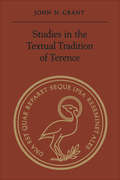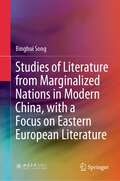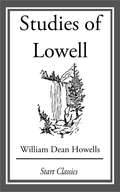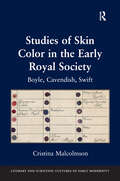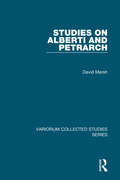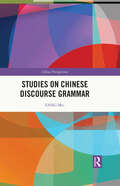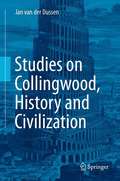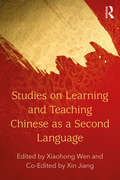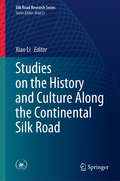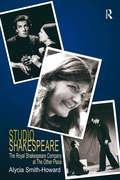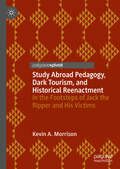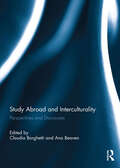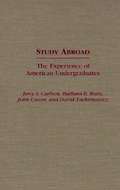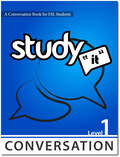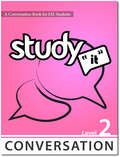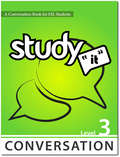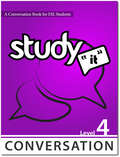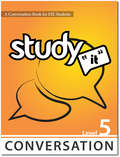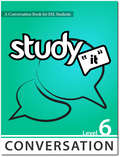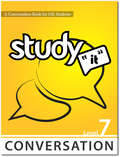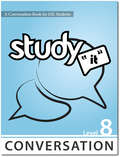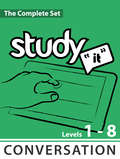- Table View
- List View
Studies in the Textual Tradition of Terence
by John N. GrantThe textual tradition of the Latin dramatist Publius Terentius Afer (second century BC) is unusually rich and complex. Over six hundred manuscripts containing some or all of Terence's six comedies have survived, but only one codex and three small fragments date from antiquity. All the rest were copied in the Middle Ages and the Renaissance when Terence was very popular. Recently scholars have been devoting considerable study to the role of his works and the commentaries on them in the cultural and intellectual development of the Middle Ages and the Renaissance. However, little attention has been given to an examination and re-examination of the manuscripts in order to determine which are the most useful for establishing a reliable text of the plays. In this study John N. Grant examines afresh the manuscript tradition of the comedies, looking in particular at a branch of the medieval manuscripts which has been neglected in the past. He establishes the primacy of one manuscript, the value of which has hitherto been disputed, and points out the importance of others which have been known but have been neglected by past editors of Terence. In addition, through a careful study of the cycle of illustrations that appear in some medieval manuscripts he brings under scrutiny the history of the transmission of the text in late antiquity. He shows that, contrary to the generally held view, the date of the original cycle of illustrations from which those in the medieval manuscripts are derived cannot be used to provide a chronological keystone for the lost ancient manuscripts which were the ancestors of the surviving witnesses. An appendix with a selection of readings from over 150 manuscripts will be of value to those interested in investigating further the relationships among the extant manuscripts. This study lays the foundation for a new edition of the plays of Terence.
Studies of Literature from Marginalized Nations in Modern China, with a Focus on Eastern European Literature
by Binghui SongThis book presents the first systematic study of the 100-year history of translation, research, reception, and influence of Central and Eastern European literature in China from the late Qing Dynasty to the end of the twentieth century. This study of Eastern European literature from the perspective of Sino-foreign literary relations is based on extensive research into the translation and reception of Central and Eastern European writers such as Milan Kundera, Sándor Petőfi, Henryk Sienkiewicz, Julius Fucik, and Bertolt Brecht. Since the late nineteenth century, the major Chinese writers have paid special attention to the literature of the marginalized Eastern European nations when they have to translate from translations since few of them understand Eastern European languages. The book seeks to identify what attracted the founders of new Chinese literature to Eastern European literature and to define its unique significance for the construction of modern Chinese literature.
Studies of Lowell
by William Dean HowellsIn those walks of ours I believe he did most of the talking, and from his talk then and at other times there remains to me an impression of his growing conservatism. I had in fact come into his life when it had spent its impulse towards positive reform, and I was to be witness of its increasing tendency towards the negative sort.
Studies of Skin Color in the Early Royal Society: Boyle, Cavendish, Swift (Literary And Scientific Cultures Of Early Modernity Ser.)
by Cristina MalcolmsonArguing that the early Royal Society moved science toward racialization by giving skin color a new prominence as an object of experiment and observation, Cristina Malcolmson provides the first book-length examination of studies of skin color in the Society. She also brings new light to the relationship between early modern literature, science, and the establishment of scientific racism in the nineteenth century. Malcolmson demonstrates how unstable the idea of race remained in England at the end of the seventeenth century, and yet how extensively the intertwined institutions of government, colonialism, the slave trade, and science were collaborating to usher it into public view. Malcolmson places the genre of the voyage to the moon in the context of early modern discourses about human difference, and argues that Cavendish’s Blazing World and Swift’s Gulliver’s Travels satirize the Society’s emphasis on skin color.
Studies on Alberti and Petrarch (Variorum Collected Studies #1012)
by David MarshLeon Battista Alberti (1404-1472) was the most versatile humanist of the fifteenth century: author of numerous compositions in both Latin and Italian, and a groundbreaking theorist of painting, sculpture, and architecture. His Latin writings owe much to the model of Petrarch (1304-1374), the famed poet of the Italian Canzoniere, but also a prolific author of Latin epistles, biographies, and poems that sparked the revival of classical culture in the early Italian Renaissance. The essays collected here reflect some thirty years of research into these pioneers of Humanism, and offer important insights into forms of Renaissance 'self-fashioning' such as allegory and autobiography.
Studies on Chinese Discourse Grammar (China Perspectives)
by FANG MeiThis book extends the traditional research perspective of single sentences and contexts to the textual structure of real discourse materials. Taking discourse functional grammar as its theoretical orientation, the book combines relevant theories with Chinese practice to work on a number of topics, including discourse phenomena and syntactic integration, the information status and discourse function of special syntactic structures, the emergence of discourse functions of metadiscourse components, and stylistic differences and their syntactic manifestations. Syntactic-semantic laws and discourse functions are examined in relation to each other, which better reveals their inner connection; a focus on the shaping of grammatical structures by interactional factors brings to light the functional motivations behind grammatical rules. In contrast to traditional Chinese grammar research, which takes individual simple or complex sentences as the object of study, this book mainly analyses grammatical phenomena that span sentences. By broadening the scope of research, it enables further exploration of issues that are difficult to address satisfactorily at the sentence level, thus enriching the study of Chinese grammar. The book will be of great interest to students and scholars of interactional linguistics, Chinese linguistics and functional grammar.
Studies on Collingwood, History and Civilization
by Jan Van der DussenThis volume is divided into three parts. The first explores various aspects of Collingwood's philosophy of history, offering a follow-up to themes discussed in the author's revised edition of History as a Science. The Philosophy of R. G. Collingwood(Springer, 2012). After a general introduction to Collingwood's philosophy of history, his manuscript The Principles of History of 1939 is discussed. This manuscript was considered 'lost' for some time but has been rediscovered in 1995. Other topics dealt with are Collingwood's philosophy of history in the year of his An Autobiography(1939), the philosophical context of his re-enactment theory, his views on the notions of process, progress, and civilization, as well as his unusual claim that history is a science. The following four essays of the second part deal with various aspects relating to the study of history and historiography. As regards the latter subject, attention is paid to the works of Herodotus and Toynbee, who correspond in having a wide scope and having been under debate. With respect to the study of history, the crucial notion of evidence is addressed, while a critical appraisal is made of the way the idea of a 'real' past is dealt with by Ankersmit. The third part of the volume discusses issues related to Western civilization and culture, and topics that are of global relevance. Both are dealt with from a historical and philosophical perspective. The first two essays focus on the rupture that occurred in Europe since the end of the eighteenth century as regards the relationship between past, present, and future, resulting in a loss of historical consciousness, and feelings of disorientation and crisis. The last three essays address the global issues of the responsibility for future generations and universal human rights, as well as the more general theme of the relationship between the West and the non-Western world.
Studies on Learning and Teaching Chinese as a Second Language
by Xin Jiang Xiaohong Sharon WenStudies on Learning and Teaching Chinese as a Second Language represents the current advances in the field. It showcases theoretically motivated empirical studies and diverse methods used for a better understanding of how Chinese language is acquired as a second or foreign language. This contributes to L2 acquisition research in general and L2 Chinese specifically. Furthermore, this research is useful for teachers seeking to understand their students’ learning processes and adjust their pedagogical approach for more effective instruction. The book bridges the gap between research and instruction by providing pedagogical implications rooted in empirical findings.
Studies on the History and Culture Along the Continental Silk Road (Silk Road Research Series)
by Xiao LiThis book presents outstanding articles addressing various aspects related to the ancient Silk Road, in particular the cultural, political, and economic interactions that took place among the civilizations and cultures on the Eurasian continent. In addition, the articles help to reveal the hallmark features of cultural communication in Inner Asia in different historical periods. The book develops a new approach to studying the civilizations of the Silk Road, promotes interdisciplinary and multi-dimensional research, sets a new direction for Chinese ancient classics and western sinology, and presents the latest discoveries, including both archaeological finds and historical documents.
Studio Shakespeare: The Royal Shakespeare Company at The Other Place
by Alycia Smith-HowardAn extensive history of The Royal Shakespeare Company's studio theatre, Studio Shakespeare: The Royal Shakespeare Company at The Other Place also includes a biography of its founder and first artistic director, Mary Ann 'Buzz' Goodbody (1947-75). Alycia Smith-Howard reveals how, as a socialist, feminist, and the RSC's first female director, Goodbody sought to invigorate classical theatre and its approach to producing the works of Shakespeare. The Other Place, which opened its doors in 1973, was her greatest achievement, and was, in the words of Ron Daniels of the American Repertory Theatre, 'a training ground for an entire generation of Shakespeare actors and directors'. The volume examines Shakespeare productions at The Other Place from 1973 to its closure in 1989. The author's sources include Goodbody's 'Mission Statement' for the studio theatre as well as other previously unavailable materials such as Goodbody's private papers, journal entries, director's notes and correspondence. In addition, it contains interviews and commentary from such theatrical luminaries as Judi Dench, Ian McKellen, Ben Kingsley, Cicely Berry, Trevor Nunn, Peter Hall, Patrick Stewart, and many others. Smith-Howard's narrative discusses productions of twelve plays at The Other Place, among them King Lear (1974), Hamlet (1975), The Merchant of Venice (1978), Antony and Cleopatra (1982), King John (1988) and Othello (1989). The cast lists of productions at The Other Place are included in an appendix. Smith-Howard's study captures the spirit and ethos of an important and radical exercise in theatre which influenced the mainstream work of The Royal Shakespeare Company. It is a lucid, compelling and valuable contribution not only to Shakespeare studies but also to theatre history. This book, as directors once said, 'has legs'.
Study Abroad Pedagogy, Dark Tourism, and Historical Reenactment: In the Footsteps of Jack the Ripper and His Victims
by Kevin A. MorrisonThis book is a genre-breaking response to the literature on study abroad. It stakes claim to an uncharted space between reflective pedagogy, public history studies, and investigations into dark tourism. Drawing on the author’s experience of teaching short-term summer programs and courses in London between 2011 and 2018 that focused wholly or in part on the Whitechapel murders of 1888, the book analyzes experiential learning in the study abroad context. The book is informed by the instructor’s reflections; students’ informal essays and anonymous evaluations; and the scholarship of teaching and learning. It begins by situating programs and courses on the Whitechapel murders in the context of debates about overseas and experiential learning. It then proceeds to discuss the constraints to and possibilities for devising study abroad programs to include graduate students in humanistic disciplines; assignments and classroom activities utilized, including those with a reenactment component; the ethical complexities of teaching at dark sites; and the pedagogical implications of learning about Jack the Ripper in an age of terror. It concludes with reflections on the differences between study abroad programs and courses in cultivating students’ global-mindedness.
Study Abroad and Second Language Use
by Valerie A. Pellegrino AveniLimitations in linguistic and cultural knowledge make self-presentation a more difficult task when we interact in a new language in a foreign country. This volume explores the problems faced by language students embarking on "study abroad" programs by considering factors that complicate self-presentation and how students overcome them. The book's insight makes it an invaluable resource for professionals in second language acquisition, and for teachers and students preparing for study abroad.
Study Abroad and interculturality: Perspectives and discourses
by Claudia Borghetti and Ana BeavenStudy abroad (SA) as a domain of inquiry in the field of Applied Linguistics has been approached from a variety of different perspectives. Although originally focused on measuring the impact of residence abroad on students’ language development, in the last decade the so-called ‘social’ turn in Second Language Acquisition has brought to the fore the importance of socio-cultural aspects of the students’ experiences (such as the amount of contact they have with the local community, their social networks, etc.). This focus on the students’ entire lived experiences in the destination country opened the door to an increased interest in analysing their language encounters in terms of intercultural learning.This new domain of investigation in SA research, focused on the students’ opportunities for intercultural development while abroad, is varied in terms of perspectives and discourses, as it catalyses the different interests and viewpoints of the various stakeholders, including educational institutions, international political organisations, teachers or the students themselves. This book gathers some of these voices, with contributions on topics such as the features, dynamics, advantages and shortcomings, preparation needs and pedagogical issues relating to student mobility in terms of the participants’ intercultural learning. This book was originally published as a special issue of Language and Intercultural Communication.
Study Abroad: The Experience of American Undergraduates
by Jerry S. Carlson Barbara B. Burn John Useem David YachimoiviczThis book describes the research design, results, and implications of an investigation of American college students who participated in study abroad programs.
Study Abroad: Traditions and New Directions (Teaching Languages, Literatures, and Cultures #5)
by Miriam Fuchs and Sarita RaiThanks to an increasingly interconnected global economy, the role of study abroad in twenty-first-century education has expanded. Student participation continues to grow as disciplinary offerings broaden; meanwhile, programs face persistent challenges to maximize access, strengthen language learning and multicultural awareness, reduce research bias, ensure funding, and maintain safety and security.Designed as a resource for use in creating and conducting courses and programs overseas, Study Abroad: Traditions and New Directions presents a diverse picture of options for study abroad. Contributors' experiences teaching in Asia, Africa, Europe, the Caribbean, and Central America inform analyses of global trends, recommendations for enhanced learning, and course models that can be adapted for a variety of programs and locations. Essays discuss current policies, procedures, and formats including language immersion, interdisciplinary studies, mentored research, professional training abroad, service learning, and institutional partnerships.
Study Guide for Contemporary Linguistics: An Introduction (7th Edition)
by Mark Aronoff William O'Grady John Archibald Janie Rees-MillerThe Study Guide that accompanies Contemporary Linguistics is designed to be more comprehensive than a simple workbook, and as such it includes summaries and reviews of important concepts found in Chapters 1 through 8 of the textbook as well as extensive supplementary practice exercises. It is particularly well suited to those undergraduate and graduate students with no prior knowledge of linguistics; it may also be profitably used by students who need additional self-study material, by professors who need supplementary lecture material, and by teaching assistants who need to organize recitation sections.
Study It Conversation Level 1: A Conversation Book for ESL Students (Study It)
by James Rice Jamie MatechukWinner 2015 Digital Book Award - Academic Category Awarded QED Certification for Quality, Excellence and Design The Study It Conversation series is an easy-to-use speaking-based ESL textbook for ESL students, language teachers and English language programs in schools or language schools. The Study It English ESL Conversation series consists of 8 different levels and 8 different English conversation books. The Study It Conversation series consists of the following: 20 different conversation topics, vocabulary-building exercises, video and audio exercises, clear language points for each conversation topic, Communicative and Project-based learning activities. Book 1 is designed for Beginner students. Some of the conversation topics in Book 1 include: Ordering at a Restaurant, Meeting People, Time Talk, Hotel Reservations and much more. ESL Teachers can access our online community which offers teachers a chance to share ideas for improving the English class. Teachers interested in Mobile Learning, Project-Based Learning or Flipping the Classroom will enjoy the Study It series.
Study It Conversation Level 2: A Conversation Book for ESL Students (Study It)
by James Rice Jamie MatechukWinner 2015 Digital Book Award - Academic Category Awarded QED Certification for Quality, Excellence and Design The Study It Conversation series is an easy-to-use speaking-based ESL textbook for ESL students, language teachers and English language programs in schools or language schools. The Study It English ESL Conversation series consists of 8 different levels and 8 different English conversation books. The Study It Conversation series consists of the following: 20 different conversation topics, vocabulary-building exercises, video and audio exercises, clear language points for each conversation topic, Communicative and Project-based learning activities. Book 2 is designed for Beginner and Pre-Intermediate level students. Some of the conversation topics in Book 2 include: Pet Peeves, Narrating a Story, Renting a Car, Buying and Selling and much more. ESL Teachers can access our online community which offers teachers a chance to share ideas for improving the English class. Teachers interested in Mobile Learning, Project-Based Learning or Flipping the Classroom will enjoy the Study It series.
Study It Conversation Level 3: A Conversation Book for ESL Students (Study It)
by James Rice Jamie MatechukWinner 2015 Digital Book Award - Academic Category Awarded QED Certification for Quality, Excellence and Design The Study It Conversation series is an easy-to-use speaking-based ESL textbook for ESL students, language teachers and English language programs in schools or language schools. The Study It English ESL Conversation series consists of 8 different levels and 8 different English conversation books. The Study It Conversation series consists of the following: 20 different conversation topics, vocabulary-building exercises, video and audio exercises, clear language points for each conversation topic, Communicative and Project-based learning activities. Book 3 is designed for Pre-Intermediate and Intermediate students of ESL. Some of the conversation topics in Book 3 include: Like vs Dislike, Introduction to Idioms, Amazing Experiences, and On thePphone etc. ESL Teachers can access our online community which offers teachers a chance to share ideas for improving the English class. Teachers interested in Mobile Learning, Project-Based Learning or Flipping the Classroom will enjoy the Study It series.
Study It Conversation Level 4: A Conversation Book for ESL Students (Study It)
by James Rice Jamie MatechukWinner 2015 Digital Book Award - Academic Category Awarded QED Certification for Quality, Excellence and Design The Study It Conversation series is an easy-to-use speaking-based ESL textbook for ESL students, language teachers and English language programs in schools or language schools. The Study It English ESL Conversation series consists of 8 different levels and 8 different English conversation books. The Study It Conversation series consists of the following: 20 different conversation topics, vocabulary-building exercises, video and audio exercises, clear language points for each conversation topic, Communicative and Project-based learning activities. Book 4 is designed for Intermediate students of ESL. Some of the conversation topics in Book 4 include: Giving Advice, Complaining and Apologizing, Podcasts, Idioms, Narrating a Story, Unsolved Mysteries, Emergencies, and many more. ESL Teachers can access our online community which offers teachers a chance to share ideas for improving the English class. Teachers interested in Mobile Learning, Project-Based Learning or Flipping the Classroom will enjoy the Study It series.
Study It Conversation Level 5: A Conversation Book for ESL Students (Study It )
by James Rice Jamie MatechukWinner 2015 Digital Book Award - Academic Category Awarded QED Certification for Quality, Excellence and Design The Study It Conversation series is an easy-to-use speaking-based ESL textbook for ESL students, language teachers and English language programs in schools or language schools. The Study It English ESL Conversation series consists of 8 different levels and 8 different English conversation books. The Study It Conversation series consists of the following: 20 different conversation topics, vocabulary-building exercises, video and audio exercises, clear language points for each conversation topic, Communicative and Project-based learning activities. Book 5 is designed for Intermediate and Upper-Intermediate students of ESL. Some of the conversation topics in Book 5 include: Giving a Presentation, Travel and Tourism, Marriage, Creating a Commercial etc. ESL Teachers can access our online community which offers teachers a chance to share ideas for improving the English class. Teachers interested in Mobile Learning, Project-Based Learning or Flipping the Classroom will enjoy the Study It series.
Study It Conversation Level 6: A Conversation Book for ESL Students (Study It )
by James Rice Jamie MatechukWinner 2015 Digital Book Award - Academic Category Awarded QED Certification for Quality, Excellence and Design The Study It Conversation series is an easy-to-use speaking-based ESL textbook for ESL students, language teachers and English language programs in schools or language schools. The Study It English ESL Conversation series consists of 8 different levels and 8 different English conversation books. The Study It Conversation series consists of the following: 20 different conversation topics, vocabulary-building exercises, video and audio exercises, clear language points for each conversation topic, Communicative and Project-based learning activities. Book 6 is designed for upper-Intermediate students of ESL. Some of the conversation topics in Book 6 include: Arguing and Compromise, At Work, Online Dating and much more ESL Teachers can access our online community which offers teachers a chance to share ideas for improving the English class. Teachers interested in Mobile Learning, Project-Based Learning or Flipping the Classroom will enjoy the Study It series.
Study It Conversation Level 7: A Conversation Book for ESL Students (Study It)
by James Rice Jamie MatechukWinner 2015 Digital Book Award - Academic Category Awarded QED Certification for Quality, Excellence and Design The Study It Conversation series is an easy-to-use speaking-based ESL textbook for ESL students, language teachers and English language programs in schools or language schools. The Study It English ESL Conversation series consists of 8 different levels and 8 different English conversation books. The Study It Conversation series consists of the following: 20 different conversation topics, vocabulary-building exercises, video and audio exercises, clear language points for each conversation topic, Communicative and Project-based learning activities. Book 7 is designed for Upper-Intermediate and Advanced students of ESL. Some of the conversation topics in Book 7 include: Fears and Phobias, Cold Feet, Driving, Advanced Idioms, Global Warming and much more ESL Teachers can access our online community which offers teachers a chance to share ideas for improving the English class. Teachers interested in Mobile Learning, Project-Based Learning or Flipping the Classroom will enjoy the Study It series.
Study It Conversation Level 8: A Conversation Book for ESL Students (Study It )
by James Rice Jamie MatechukWinner 2015 Digital Book Award - Academic Category Awarded QED Certification for Quality, Excellence and Design The Study It Conversation series is an easy-to-use speaking-based ESL textbook for ESL students, language teachers and English language programs in schools or language schools. The Study It English ESL Conversation series consists of 8 different levels and 8 different English conversation books. The Study It Conversation series consists of the following: 20 different conversation topics, vocabulary-building exercises, video and audio exercises, clear language points for each conversation topic, Communicative and Project-based learning activities. Book 8 is designed for Advanced students of ESL. Some of the conversation topics in Book 8 include: Plan a Town, Meeting Up, Business Meetings, Cross Cultural Confusion and much more ESL Teachers can access our online community which offers teachers a chance to share ideas for improving the English class. Teachers interested in Mobile Learning, Project-Based Learning or Flipping the Classroom will enjoy the Study It series.
Study It Conversation Levels 1-8: The Complete Set (Study It)
by James Rice Jamie MatechukWinner 2015 Digital Book Award - Academic Category Awarded QED Certification for Quality, Excellence and Design The Study It Conversation series is an easy-to-use conversation-based English textbook for ESL students, language teachers and English language programs in schools or language schools. The Study It English as a Second Language Conversation series consists of 8 different levels and 8 different textbooks. It is an exciting new series for teachers interested in Mobile Learning, Project-Based Learning or Flipping the Classroom that includes built-in lesson plans. Study It Conversation - The Complete Set consists of all conversation textbooks combined into one easy-to-use book All audio and video exercises are included in the book. ESL Teachers can access our online community which offers teachers a chance to share ideas for improving the English class
